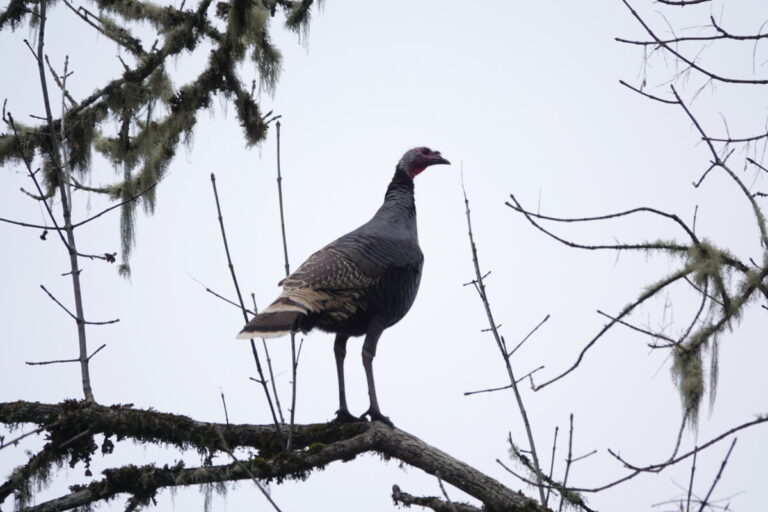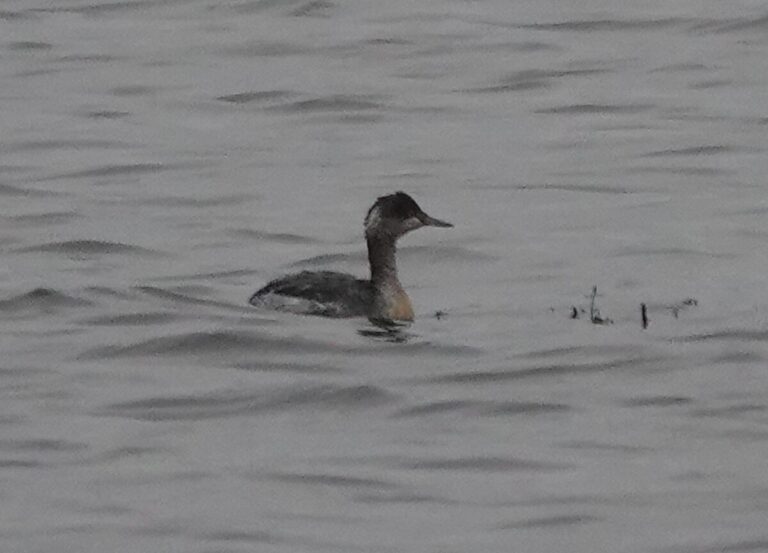Featured Image: In the low light of dawn, in sub-freezing temperatures, a lone Snow Goose flies with a group of Cackling Geese at Ford’s Pond, west of Sutherlin, December 17, 2022.
My fingers were hurting for the first 4 or 5 hours of the day, December 17, 2022, the 49th annual Roseburg-Sutherlin Christmas Bird Count. I had been owling for several hours before dawn, and it wasn’t until mid- to late morning that temperatures reached 32F. This early-season CBC typically has temperatures in the 40s, so I guess I am spoiled. Respect to those counting in North Dakota!
A wonderful 44 birders participated this year, in 19 areas or sub-areas and four feeder counts, including at least a half-dozen new folks. Thank-you to all!!! I was grateful and impressed especially with those that volunteered to cover areas where needed and serve as partners for individual counters. Birding partners make the day more safe and can make it more fun! Just look at the faces below and tell me if you think they are having a good time! 🙂
What does the Christmas Bird Count mean to you? Is it about monitoring bird populations? Making friends? Enjoying the outdoors? Tell me your thoughts in the comments.
Okay…to the birds!
This year we recorded a total of 22,021 individual birds, down from 26,490 last year, but higher than 19,461 the year before; just in between. Total CBC numbers year to year are largely influenced by variations in numbers of abundant species such as American Robins as explained in the 2019 summary, and this year appears to be no exception, with a moderate number of robins.
In terms of total number of species, however, this CBC season was a record-breaking year for the Roseburg-Sutherlin CBC. An astonishing 127 species were recorded; that’s seven more than our previous high of 120 in 2014, and 15 more species than our average of about 112 species. That’s not an incremental increase, but a big leap. What brought this about is hard to say. Interestingly, a notable number of western Oregon CBCs reported record numbers this season, so the primary cause may not be local. Nevertheless, our CBC this year included more people counting smaller areas, giving more birders more time to cover their areas. This means more time on foot and less time in the car, which always results in finding more birds. Congratulations to the birding eyes out there!
Habitats throughout the 15-mile diameter count circle (centered in Wilbur) continue to change. Over the last 10-20 years, hundreds of acres of grassland and pasture have been converted to blueberries and vineyards. Ford’s Pond is being developed into a community park. Thankfully most of it will remain in natural condition. Below is a set of photos by Liz Gayner at Umpqua Sand & Gravel, where she and Rex McGraw counted birds this year. For the second year now, habitat at Umpqua Sand & Gravel has changed to include a golf course and RV Park. Thankfully, plenty of good habitat remains there and the green grass is enjoyed by geese, bluebirds, and others.
The ten most numerous species this year were: AMERICAN ROBIN (4021), EUROPEAN STARLING (3022), AMERICAN COOT (1374), DARK-EYED JUNCO (1349), CANADA GOOSE (1247), NORTHERN SHOVELER (1246), BREWER’S BLACKBIRD (894), AMERICAN WIGEON (632), WILD TURKEY (563), RUDDY DUCK (427). Northern Shoveler and Ruddy Duck don’t usually make this list, but Ford’s Pond has been hosting larger than usual numbers of these species, as well as Pied-billed Grebes. Mallard (408), Rock Pigeon (238), and Cedar Waxwing (5, yes five), in the top ten last year, did not make the cut this year.
Looking at the numbers in terms of geographic occurrence, the ten most widespread species, found in 17 or more of 19 fully covered team areas were: NORTHERN FLICKER (19), AMERICAN ROBIN (19), DARK-EYED JUNCO (19), CALIFORNIA SCRUB-JAY (18), WESTERN BLUEBIRD (18), EUROPEAN STARLING (18), MALLARD (17), RED-TAILED HAWK (17) BLACK-CAPPED CHICKADEE (17), GOLDEN-CROWNED SPARROW (17), and SPOTTED TOWHEE (17). Top widespread species from last year not making the cut this year were American Kestrel (14) and Canada Goose (16). In contrast, 24 species (possibly a record) were found in only one team area and not found by any other team (see links to summary tables near the end for more detail).
Seven teams–more than usual–did at least a little bit of owling, and several teams made big efforts, so we recorded a record number of SEVEN OWL SPECIES this year: BARN OWL (5), WESTERN SCREECH-OWL (1), GREAT-HORNED OWL (12), NORTHERN PYGMY-OWL (1), BARRED OWL (1), LONG-EARED OWL (1), NORTHERN SAW-WHET OWL (5). In particular, Madrone Ruggiero made tremendous efforts in both the morning and evening of the count, recording the only Barred Owl at 11:58 pm the evening of count day. Barred Owls, while present in our area for many years now, are not frequent vocalizers, making them difficult to detect. The species was recorded on the CBC for the first time in 2017.
One all-time new species was added to the count this year, which has been run consecutively for 49 years now: An adult male BLACK-THROATED BLUE WARBLER was seen and photographed by Matt Hunter on private property in SW Sutherlin. An arrangement with the landowner has allowed many others to view the bird as it continues to feed on sap and insects at sap wells maintained by a Red-Breasted Sapsucker on the property.
An astonishing 10 species were observed that have been detected 10 times or fewer: BLACK-THROATED BLUE WARBLER (1), GLOSSY/WHITE-FACED IBIS (2), LONG-EARED OWL (2), BARRED OWL (4), EARED GREBE (5), AMERICAN BITTERN (5), PRAIRIE FALCON (7), CINNAMON TEAL (8), TURKEY VULTURE (8), SNOW GOOSE (10). The ibis is currently identified only as Glossy/White-faced because it is an immature bird, it still has a dark eye, and species diagnostic features may not show up until mid- to late winter or spring. We hope it sticks around long enough to identify it to species. The Long-eared Owl responded to Keith Phifer’s night-time playback of Northern Pygmy-Owl and was recorded and fuzzily photographed. Two American Bitterns were heard, one at each end of Cooper Creek Reservoir, by Robin Hartmann and crew. Robin went back a few days later and recorded the diagnostic calls of one of the birds, which were never seen. The Prairie Falcon was observed and photographed by Abraham Finlay along the outer end of Troost Street.
Record high counts were made for an astonishing 18 species including: CINNAMON TEAL (3), NORTHERN SHOVELER (1246), COMMON GOLDENEYE (47), RUDDY DUCK (427), WILD TURKEY (563), AMERICAN BITTERN (2), COOPER’S HAWK (12), BALD EAGLE (29), VIRGINIA RAIL (11), SORA (3), LEAST SANDPIPER (52), BARN OWL (5), NORTHERN SAW-WHET OWL (5), ANNA’S HUMMINGBIRD (65), ACORN WOODPECKER (165), BLACK PHOEBE (67), SAY’S PHOEBE (3), WHITE-BREASTED NUTHATCH (57). We had no record lows this year. Some of you might logically ask: “Well, does that mean our winter bird populations are doing well here?” One cannot actually determine trends from these numbers alone, because these numbers also reflect an increasing number of counters and total hours observing. That is why analyses of trends are based on bird numbers per effort rather than just the number of birds reported (see here). Only one species was missed that had been recorded on 30 or more of 48 historical counts: WESTERN GREBE (37).
Although not making any other particular list in this compilation, the flock in the following photo is something that few birders have seen before. Do you know what these birds are? At first glance, you would be right to say “they look like starlings.” The species in this photo has a shape somewhat similar to starlings. But this is an unusually large flock of our state bird, Western Meadowlark. The cropped photo shows more detail to confirm. This flock of at least 120 birds has been present out Troost Street much of this winter, in large unused fields. These same fields have this winter hosted Rough-legged Hawk, Northern Shrike, Prairie Falcon, and Say’s Phoebe among others (most found by Abraham Finlay), demonstrating the unique value of ungrazed and unmowed grassland.
For a more detailed look at the numbers this year, check out these summary tables (also available at www.umpquabirds.org/cbc):
**Numbers of birds recorded by team area–sorted by taxonomy
**Numbers of birds recorded by team area–sorted by total number of each species
**Numbers of birds recorded by team area–sorted by number of teams recording each species
Thank-you again to all who participated in birding, organizing, and photography. Thank-you to Jeannie Pollock for data entry. Thank-you to Tracy Maxwell and Umpqua Valley Audubon for organizing our countdown dinner, and to Serge Queant and others for preparing food. Thank-you to everyone that did their part to make the count a successful, enjoyable event!
For more information on Christmas Bird Counts in Douglas County, see www.umpquabirds.org/cbc. Hope to see y’all and your friends next year!!!






































This Post Has 12 Comments
Very nicely done Matt! Thanks for including Kelly and I as one of the many birding partners out there! All the bird photos by Liz, Abraham, and yourself and the summarization of all the data is so fascinating. It is just special to be able to see what all our efforts found in the day!
This was a wonderful write up about the CBC! I am very grateful to you Matt for organizing this entire event. I am also VERY grateful to all of the 40+ participants who braved the cold and did the hard work! Lovely photos! (they really do make the write up awesome!) Another big thanks to Serge who made the best fish chowder I have ever had! and my personal thanks to all the volunteers (including the ASTRA club and the board members of UVAS) for the support with the post count dinner and event! This was my first CBC and will now be a new tradition for me! Thank you, EVERYBODY who contributed! Tracy
Thanks Matt!
Matt….
Not fair. I do a report of our Coquille account. But I do not include photos. Now I am going to have participants like Contreras demanding that I meet your standards.
Nice report!
Harv Schubothe
Haha! Harv, I’ve been doing it this way for about 8 years now, so I think you’re off the hook. 🙂
https://mghwildlife.com/cbcs/
Wow! Thanks for the great article Matt! Was a fun (but cold) day of birding! :0)
Quite a haul! It was nice to have civilized weather to start the count season.
Thanks to all the talented and persevering Birders that made this possible!! Many of these I have yet to see myself, but thirst for the experience! Wonderful photography !
Maybe next year I can attend!
Hi Carol. Yes! I hope you can join us next year Carol!!! 🙂
I am very impressed at your willingness to go out to the cold to count and classify the various birds you look for! Don’t know much about birds except that they are pretty to look at and interesting when you get to know a few of them that come around our house.
Keep up the good work!
I had a lot of fun counting! Thanks for putting this together!
The very good photos add a lot. (Presuming you’re the same Abraham). Wonderful count summary by Matt.